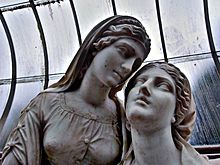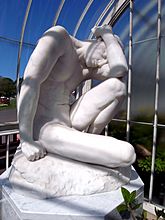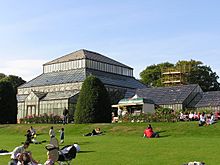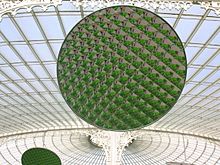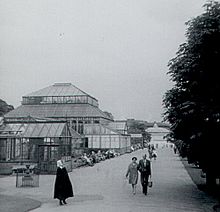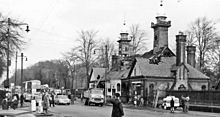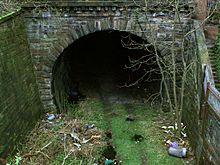Glasgow Botanic Gardens facts for kids
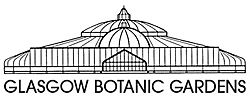 |
|
| Location | |
|---|---|
|
Key people
|
|
The Glasgow Botanic Gardens is a beautiful botanical garden found in the West End area of Glasgow, Scotland. It's famous for its many glasshouses, especially the amazing Kibble Palace.
This garden is home to a huge variety of plants from both warm and cool climates. You can explore a special herb garden and a unique "chronological bed." This bed shows plants in the order they were first brought to Scotland. The gardens also have the UK's national collection of tree ferns. In 2003, a world rose garden was opened by Princess Tomohito of Mikasa.
The River Kelvin flows along one side of the gardens. It then goes through Kelvingrove Park. A walking path connects these two lovely green spaces. In 2011, the Botanic Gardens won a Green Flag Award for being a great park.
Contents
Discovering the Gardens' Past
The Glasgow Botanic Gardens started in 1817. About 8 acres (32,000 square meters) of land were set up near Sauchiehall Street in Glasgow. The Royal Botanic Institution of Glasgow ran them. This group was founded by Thomas Hopkirk and Professor James Jeffray. The gardens were meant to help the University of Glasgow with its studies.
William Hooker was a botany professor at Glasgow University. He helped a lot to develop the gardens. Later, he became the director of Kew Gardens in London. The gardens moved to their current spot in 1842.
In the past, the gardens were used for concerts and other events. In 1891, the Glasgow Corporation took over the gardens. They became part of Glasgow's public parks.
The area around the gardens once had a railway line. The old Botanic Gardens Railway Station is still there today. It's a cool example of a disused station, hidden behind trees. Another old station, Kirklee railway station, is also just inside the gardens.
Exploring the Kibble Palace
The Kibble Palace is a huge glasshouse built in the 1800s. It's made from wrought iron and covers a massive area of 2137 square meters. John Kibble first designed it for his home in Coulport in the 1860s. The parts were made by Walter Macfarlane at his factory.
The palace was brought by boat up the River Clyde to the Botanic Gardens. It was fully put together in its current spot in 1873. The building has curved iron and glass, supported by strong cast-iron beams.
At first, the Kibble Palace was used for shows and concerts. From the 1880s, it became a home for plants. Important people like Benjamin Disraeli and William Ewart Gladstone gave speeches here. After that, it was used only for growing temperate plants. The main plants you'll see are tree ferns from New Zealand and Australia. Some of these ferns have lived here for 120 years! They are now the national collection of tree ferns.
In the 1920s, a statue was added to the palace. It's of "King Robert of Sicily," a character from a poem by Henry Wadsworth Longfellow. This statue was made by a Scottish artist named George Henry Paulin.
In 2004, a big project started to fix the palace. It cost £7 million to repair the ironwork. Workers carefully took the palace apart. Each piece was sent away for special repair. The plants were moved out for the first time ever. The ironwork was then put back together with a new floor plan. This gave the palace a much longer life. It opened again to visitors in November 2006.
Today, the Kibble Palace has many different plants. You can see beautiful orchids, interesting carnivorous plants, and the famous tree ferns.
Art in Kibble Palace
The Kibble Palace is also home to several sculptures:
- King Robert of Sicily (a hero created by Longfellow) by George Henry Paulin (1927)
- Cain by Edwin Roscoe Mellins (1899)
- Eve by Scipione Tadolini (around 1870)
- Ruth by Giovanni Ciniselli (1880)
- The Sisters of Bethany by John Warrington Wood (around 1871)
- The Elf by William Goscombe John (1899)
- Stepping Stones by William Hamo Thornycroft (1878)
- The Nubian Slave by Antonio Rossetti (around 1880)
- sculptures in the Glasgow Botanic Gardens
The Gardens' Research Library
The Glasgow Botanic Gardens has a small but important research library. It holds over 2,300 main books. There are also special collections and many plant magazines. One collection is Curtis's Botanical Magazine, which has issues from 1787 until today.
This library is not like a public library. It's a special collection for people who work at the gardens. It's also for students and researchers studying plants.
Gallery
- Glasgow Botanic Gardens
-
Venus flytraps in the carnivorous plants gallery
-
Steps running down to the River Kelvin



